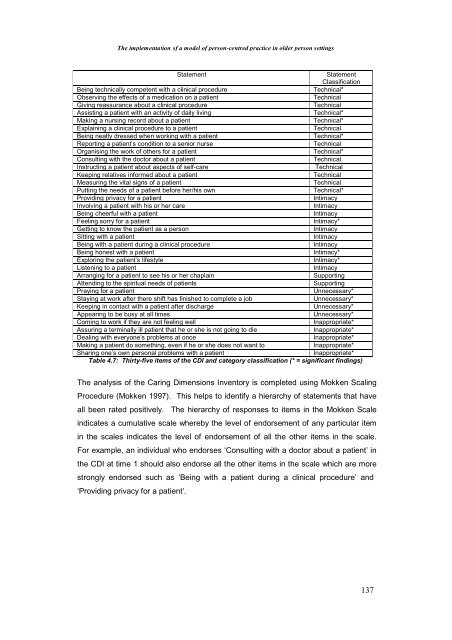The Implementation of a Model of Person-Centred Practice In Older ...
The Implementation of a Model of Person-Centred Practice In Older ...
The Implementation of a Model of Person-Centred Practice In Older ...
Create successful ePaper yourself
Turn your PDF publications into a flip-book with our unique Google optimized e-Paper software.
<strong>The</strong> implementation <strong>of</strong> a model <strong>of</strong> person-centred practice in older person settings<br />
Statement<br />
Statement<br />
Classification<br />
Being technically competent with a clinical procedure<br />
Technical*<br />
Observing the effects <strong>of</strong> a medication on a patient<br />
Technical<br />
Giving reassurance about a clinical procedure<br />
Technical<br />
Assisting a patient with an activity <strong>of</strong> daily living<br />
Technical*<br />
Making a nursing record about a patient<br />
Technical*<br />
Explaining a clinical procedure to a patient<br />
Technical<br />
Being neatly dressed when working with a patient<br />
Technical*<br />
Reporting a patient’s condition to a senior nurse<br />
Technical<br />
Organising the work <strong>of</strong> others for a patient<br />
Technical*<br />
Consulting with the doctor about a patient<br />
Technical<br />
<strong>In</strong>structing a patient about aspects <strong>of</strong> self-care<br />
Technical<br />
Keeping relatives informed about a patient<br />
Technical<br />
Measuring the vital signs <strong>of</strong> a patient<br />
Technical<br />
Putting the needs <strong>of</strong> a patient before her/his own<br />
Technical*<br />
Providing privacy for a patient<br />
<strong>In</strong>timacy<br />
<strong>In</strong>volving a patient with his or her care<br />
<strong>In</strong>timacy<br />
Being cheerful with a patient<br />
<strong>In</strong>timacy<br />
Feeling sorry for a patient<br />
<strong>In</strong>timacy*<br />
Getting to know the patient as a person<br />
<strong>In</strong>timacy<br />
Sitting with a patient<br />
<strong>In</strong>timacy<br />
Being with a patient during a clinical procedure<br />
<strong>In</strong>timacy<br />
Being honest with a patient<br />
<strong>In</strong>timacy*<br />
Exploring the patient’s lifestyle<br />
<strong>In</strong>timacy*<br />
Listening to a patient<br />
<strong>In</strong>timacy<br />
Arranging for a patient to see his or her chaplain<br />
Supporting<br />
Attending to the spiritual needs <strong>of</strong> patients<br />
Supporting<br />
Praying for a patient<br />
Unnecessary*<br />
Staying at work after there shift has finished to complete a job<br />
Unnecessary*<br />
Keeping in contact with a patient after discharge<br />
Unnecessary*<br />
Appearing to be busy at all times<br />
Unnecessary*<br />
Coming to work if they are not feeling well<br />
<strong>In</strong>appropriate*<br />
Assuring a terminally ill patient that he or she is not going to die<br />
<strong>In</strong>appropriate*<br />
Dealing with everyone’s problems at once<br />
<strong>In</strong>appropriate*<br />
Making a patient do something, even if he or she does not want to<br />
<strong>In</strong>appropriate*<br />
Sharing one’s own personal problems with a patient<br />
<strong>In</strong>appropriate*<br />
Table 4.7: Thirty-five items <strong>of</strong> the CDI and category classification (* = significant findings)<br />
<strong>The</strong> analysis <strong>of</strong> the Caring Dimensions <strong>In</strong>ventory is completed using Mokken Scaling<br />
Procedure (Mokken 1997). This helps to identify a hierarchy <strong>of</strong> statements that have<br />
all been rated positively. <strong>The</strong> hierarchy <strong>of</strong> responses to items in the Mokken Scale<br />
indicates a cumulative scale whereby the level <strong>of</strong> endorsement <strong>of</strong> any particular item<br />
in the scales indicates the level <strong>of</strong> endorsement <strong>of</strong> all the other items in the scale.<br />
For example, an individual who endorses ‘Consulting with a doctor about a patient’ in<br />
the CDI at time 1 should also endorse all the other items in the scale which are more<br />
strongly endorsed such as ‘Being with a patient during a clinical procedure’ and<br />
‘Providing privacy for a patient’.<br />
137
















